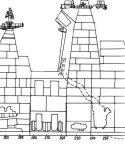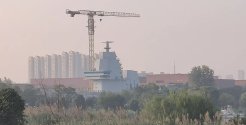I think all prior rumours have referred to two separate hulls (and at two separate shipyards) rather than a singular hull. Simply based on rumours up to this point, for better or worse I think we have to operate on the basis of a CVN and a CV being pursued.
But I think what you wrote about the island design being compatible with both conventional and nuclear power has something worth exploring...
So, building on this, I wonder if what we are looking at with this island mockup, is that it is meant to represent the island design for both a nuclear powered carrier/CVN, and a new island design for a conventionally powered carrier/CV.
If we are operating with the assumption that the rear funnel structure actually represents a smokestack, the question is how do we reconcile it with the idea of a CVN being built at DL, and the possibility of a CV being built at JN as well?
One possible unifying answer, is that the island mockup is a new design that is meant to be compatible with a CVN as well as a CV.
The picture below as reference:
- The highlighted green part is the island for the CVN, with a commensurately much smaller deckspace footprint. The green cross over the rear smokestack indicates that the smokestack is "removed"/not present on the actual real CVN.
- The highlighted red part encompasses the island and the smokestack in total, which has a deckspace footprint similar to CV-18.

In other words, there are two "island configurations":
- CVN island configuration -- island only (green)
- CV island configuration -- island and connected smokestack structure (red)
The benefits of having a common "island design" between the CVN and CV is somewhat obvious -- they can keep the internals and subsystems arrangement of the CVN and CV basically the same, with some minor benefits in construction but most of the benefits would be in training ship crew.
The benefits of having a rear-set, connected smoke stack structure for the CV configuration (versus integrated into the island like on CV-18), could be to reduce the interference of the exhaust with the primary island's activities and subsystems (radars etc).
In other words, the CV island configuration is a bit of an improvement from CV-18 by having a rear-set smoke stack structure, while also offering island commonality with the sister CVN.
Now, what this entails for the mockup itself, imo is how do we make sense of the island mockup we see and the position of the island mockup?
Because what we'd be seeing is a "CV island configuration" (island and connected smokestack), but emplaced very aft on the ship, in a position more consistent with that of a CVN rather than a CV.
I see two possible answers in turn to that question:
A) They want to test the maximal permutations of the possibilities for CVN and CV island configurations and island placements; so they are basically testing a CV island configuration (which has the largest footprint and most "structure" to work with) in the newest island placement which is in the rear of the ship (i.e.: a CVN island placement). In other words, trying to hit two birds with one stone. The actual CVN would have a CVN island configuration (i.e.: no smokestack) in the same position as we see on the mockup (very aft on the ship), and the actual CV would have a CV island configuration as we see on the mockup but in a slightly more forward position relative to where it is on the mockup.
B) A slightly less likely answer (imo) is that the actual CV will have its island placed in the location as on the mockup (very aft). In that case, what we are seeing is still a case of trying to hit two birds with one stone, where the actual CVN would have a CVN island configuration (i.e.: no smokestack) in the same position as the mockup, while the actual CV would have the CV island configuration as we see on the mockup in the same position as the mockup as well.


